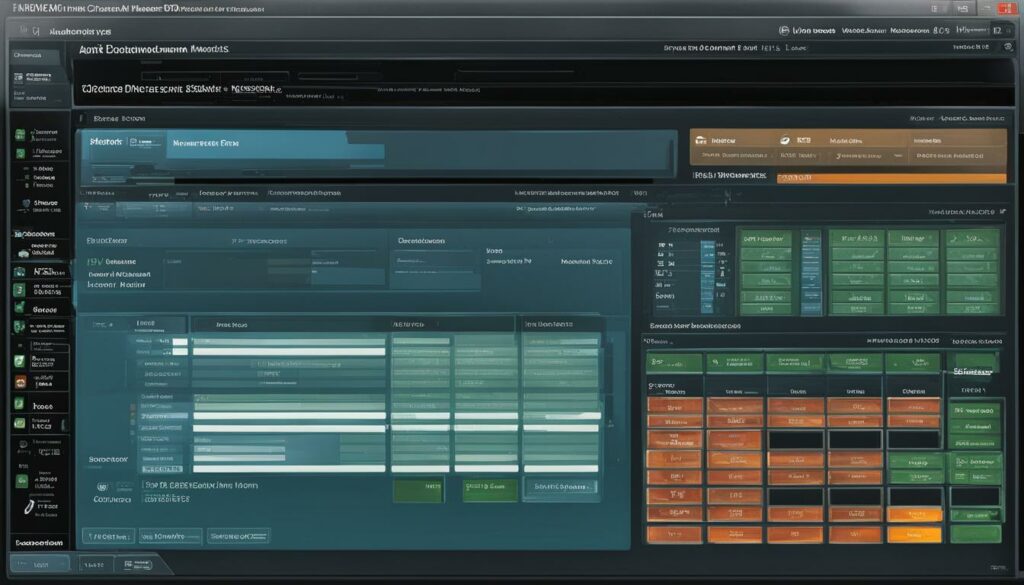Welcome to the world of domain name resolution! Have you ever wondered how your favorite websites are accessed so effortlessly? Well, the answer lies in a powerful DNS software application called BIND.
BIND, short for Berkeley Internet Name Domain, is a widely used DNS server that plays a vital role in translating human-readable domain names into IP addresses. Without BIND, the internet as we know it would not function smoothly.
Key Takeaways:
- BIND is an open-source DNS software application used for domain name resolution.
- It translates human-readable domain names into IP addresses, enabling access to websites.
- BIND has a rich history starting from its development at the University of California, Berkeley.
- Using BIND as a DNS server requires technical knowledge and expertise.
- BIND offers a multitude of features and capabilities, making it a versatile DNS management tool.
History of BIND
The history of BIND dates back to the early 1980s when it was developed at the University of California, Berkeley, by four graduate students. It was first released as BIND 4 in 1988, providing basic DNS functionality and quickly gaining popularity. However, due to increased complexity and security issues as the internet grew, BIND 8 was introduced in 1997 with significant improvements. The currently supported version is BIND 9, released in 2000, which offers enhanced features, security, and support for modern DNS standards.
BIND has a rich history that spans several decades, evolving to meet the changing needs of the internet. From its humble beginnings as BIND 4 to the sophisticated and robust BIND 9, this DNS software application has played a vital role in shaping the domain name resolution process.
To understand the impact of BIND, it is essential to explore its journey from inception to the present day. The advancement of BIND showcases its continuous adaptation to the evolving landscape of technology and the internet.
| Version | Release Year | Key Features |
|---|---|---|
| BIND 4 | 1988 | Basic DNS functionality |
| BIND 8 | 1997 | Improvements in complexity and security |
| BIND 9 | 2000 | Enhanced features, security, and support for modern DNS standards |
Throughout its history, BIND has been instrumental in ensuring the smooth functioning of the internet, enabling seamless communication between users and resources on the web. Its evolution and continuous development highlight its essential role as a DNS software application.
How to Use BIND
Setting up and using BIND as a DNS server requires some technical knowledge and expertise. By following the general steps below, you can configure BIND and ensure a secure and reliable DNS infrastructure:
- Install BIND on your preferred operating system.
- Edit the named.conf file to configure BIND based on your requirements.
- Create zone files for each domain you want to manage.
- Configure forwarding and caching to optimize DNS resolution.
- Start the BIND service to enable DNS functionality.
Remember to regularly update BIND with the latest security patches to protect against vulnerabilities and ensure optimal performance. Following best practices for configuration and maintenance will help keep your DNS server stable and reliable.
If you’re looking for a reliable WordPress hosting solution that works seamlessly with BIND, we recommend BoostedHost. With BoostedHost’s WordPress Hosting, you can enjoy optimal performance and security for your website. Sign up now through this link to get started.

Expert Tip:
When configuring BIND, it’s important to pay attention to security measures, such as restricting zone transfers, implementing access controls, and enabling DNSSEC for enhanced security. Regularly monitoring your DNS server’s performance and troubleshooting any issues promptly will help maintain a reliable DNS infrastructure.
Features & Capabilities of BIND
BIND, as a DNS management tool, offers a plethora of features and capabilities that make it highly desirable in the industry. Let’s explore some of its key functionalities:
Support for Authoritative DNS
One of the notable features of BIND is its ability to serve as an authoritative DNS server, acting as the primary source of domain zone data. With BIND, you can efficiently manage and control DNS records for your domains.
Caching Resolver
BIND acts as a caching resolver, greatly improving query response times. By storing frequently accessed DNS information, BIND reduces the need to repeatedly fetch data from external DNS servers, resulting in faster and more efficient name resolution.
DNS Load Balancing
BIND also provides basic DNS load balancing capabilities by distributing the workload across multiple DNS servers. This feature ensures optimal performance, enhanced reliability, and improved scalability for your DNS infrastructure.
DNSSEC Support
Security is a critical aspect of any DNS solution, and BIND excels in this area by offering built-in support for DNSSEC (DNS Security Extensions). With DNSSEC, BIND ensures the authenticity and integrity of DNS data, protecting against DNS spoofing and other malicious activities.
Dynamic Updates
BIND allows dynamic updates to DNS records, enabling administrators to make real-time changes to zone data without the need to restart or reload the DNS server. This feature offers flexibility and convenience in managing DNS information.
Robust Support for IPv6
As the internet transitions to IPv6, BIND remains at the forefront by providing robust support for this next-generation IP protocol. With BIND, you can seamlessly manage IPv6 addresses and ensure smooth connectivity in the evolving internet landscape.
| Feature | Description |
|---|---|
| Support for Authoritative DNS | Act as a primary source of domain zone data |
| Caching Resolver | Improve query response times through caching |
| DNS Load Balancing | Distribute load across multiple servers for enhanced performance and scalability |
| DNSSEC Support | Ensure security and integrity of DNS data |
| Dynamic Updates | Allow real-time changes to DNS records |
| Robust Support for IPv6 | Manage IPv6 addresses seamlessly |
As you can see, BIND encompasses a comprehensive set of features and capabilities that make it an excellent choice for managing DNS infrastructure. Its versatility and power make it a preferred option for organizations of all sizes.
Next, let’s explore the advantages of using BIND as a DNS management tool.

Advantages of BIND
Using BIND as a DNS management tool offers several advantages for your organization. Discover why BIND is a preferred choice among professionals:
- Open-Source: BIND is an open-source software, meaning it is freely available to anyone. This cost-effective solution enables organizations to allocate resources efficiently and invest in other areas of their business.
- Stability and Reliability: With a proven track record, BIND has established itself as a reliable DNS server. Its stability ensures uninterrupted access to websites and services, minimizing downtime and keeping your online presence consistent.
- Community Support: As a popular choice, BIND boasts a large user base and an active community. This active community provides regular updates and security patches to enhance performance and protect against vulnerabilities.
- DNSSEC Support: BIND supports DNSSEC (Domain Name System Security Extensions), a protocol that enhances the security of your DNS infrastructure. DNSSEC validates and verifies the authenticity of DNS responses, reducing the risk of fraudulent activities such as DNS hijacking.
- Scalability: For high-traffic websites or organizations with complex DNS needs, BIND offers scalability. Its ability to handle a large volume of queries efficiently ensures smooth access to your resources, even during peak periods.
- Customizability: BIND provides administrators with extensive customization options. You can adjust DNS settings according to your specific requirements and preferences, allowing you to optimize the performance and functionality of your DNS infrastructure effortlessly.

By choosing BIND as your DNS management tool, you gain access to a robust and flexible solution that empowers your organization with reliability, security, and scalability. The open-source nature of BIND, combined with its community support, makes it a cost-effective choice without compromising on performance or customization options.
Disadvantages of BIND
While BIND has many advantages as a DNS management tool, it also has its share of disadvantages that need to be considered. It’s important to be aware of these drawbacks to make an informed decision about whether BIND is the right choice for your needs.
Complex Setup and Configuration
Setting up and configuring BIND can be complex and challenging, especially for those without a strong understanding of DNS and networking concepts. It requires technical knowledge and expertise to properly configure BIND as a DNS server. This complexity can make it difficult for novices or individuals without specific DNS expertise to get up and running smoothly.
Maintenance and Updates
Regular maintenance and updates are necessary to ensure the security and performance of a BIND server. Keeping up with the latest DNS standards, security patches, and bug fixes is crucial to maintain the reliability and stability of your DNS infrastructure. Failing to keep BIND updated could leave your system vulnerable to security threats and performance issues.
Resource-Intensive
BIND can be resource-intensive, meaning it requires significant hardware resources for optimal operation. It demands higher performance hardware to handle the workload efficiently, especially in cases where there is a high volume of DNS queries or complex DNS configurations. Deploying BIND on underpowered hardware may result in slower response times and degraded performance.
Potential Security Vulnerabilities
Like any software application, BIND is not immune to security vulnerabilities. While efforts are made to regularly release security patches and updates, there is always a risk of new vulnerabilities emerging. To mitigate these risks, administrators need to stay vigilant and promptly apply any available security patches to keep their BIND server secure.
Overall, BIND is a powerful and widely used DNS management tool, but it requires careful consideration of its complexities, maintenance requirements, resource demands, and potential security vulnerabilities. It is important to evaluate these disadvantages alongside its advantages to determine if BIND is the right DNS management tool for your specific needs.
| Disadvantages | Description |
|---|---|
| Complex Setup and Configuration | Setting up and configuring BIND can be challenging, especially for those without a strong understanding of DNS and networking. |
| Maintenance and Updates | Regular maintenance and updates are necessary to ensure the security and performance of a BIND server. |
| Resource-Intensive | BIND can be resource-intensive, requiring higher performance hardware for optimal operation. |
| Potential Security Vulnerabilities | Like any software application, BIND is not immune to security vulnerabilities. |

Alternatives to BIND
While BIND is a popular choice for DNS management, there are alternative DNS servers available that cater to different needs and preferences. Consider exploring these BIND alternatives:
PowerDNS
PowerDNS is known for its high performance and flexibility in data storage. It offers a range of features, including support for multiple backends, such as SQL databases and NoSQL solutions. PowerDNS is a great option for those looking for a DNS server that can handle large volumes of data efficiently.
NSD (Name Server Daemon)
NSD is favored for its simplicity and security. It is designed to be lightweight and easy to configure, making it an excellent choice for those who value ease of use and minimal resource consumption. NSD is popular among administrators seeking a straightforward DNS server option.
Windows DNS Server
For Windows-based infrastructure, the Windows DNS Server is a suitable alternative to BIND. It offers seamless integration with the Windows operating system and provides robust DNS management capabilities. If you’re already using Windows servers, the Windows DNS Server may be the most convenient choice for you.
Knot DNS
Knot DNS is renowned for its modern architecture and support for DNSSEC (Domain Name System Security Extensions). It boasts high performance and scalability, making it ideal for organizations with complex DNS needs. Knot DNS offers advanced features and robust security measures to ensure the integrity of your DNS infrastructure.
It’s important to consider your specific requirements, infrastructure, and level of expertise when selecting a DNS server alternative to BIND. Evaluate each option carefully to determine which one aligns best with your needs and preferences.
What is DNS?
The domain name system (DNS) is a crucial component of the internet that enables the translation of human-readable domain names into IP addresses. It acts as a naming database, mapping domain names to their corresponding numeric IP addresses, facilitating seamless web browsing and other online activities.
DNS utilizes a hierarchical structure and a distributed network of servers to ensure efficient and accurate name resolution. When you enter a domain name in your web browser, DNS servers work collaboratively to provide the necessary information for connecting you to the remote host associated with that domain.
By translating domain names into IP addresses, DNS makes it possible for computers and other devices to communicate effectively on the internet. Without DNS, we would need to remember and use long strings of numbers (IP addresses) to access websites and online resources.
“DNS allows computers to translate human-readable domain names into IP addresses, making web browsing and other internet activities easily accessible.” – BoostedHost
How DNS Works: An Overview
- Your web browser sends a request to your internet service provider’s (ISP) resolver when you enter a domain name.
- The resolver initiates a recursive DNS query, starting with the root name servers.
- The root name servers provide referrals to the top-level domain (TLD) servers, which are responsible for specific domain extensions (e.g., .com, .org).
- The TLD servers further direct the resolver to the authoritative name servers associated with the requested domain.
- The authoritative name servers return the IP address of the corresponding domain.
- The resolver caches this information for future use, allowing for faster access to the same domain.
- Your web browser uses the IP address to establish a connection with the remote host, allowing you to access the desired website or resource.
The Importance of DNS in Internet Connectivity
DNS plays a crucial role in enabling internet users to access websites and online services effortlessly. Without DNS, we would need to remember and manually enter lengthy IP addresses, which would be impractical and challenging for most users.
Advantages of DNS
DNS offers several advantages that contribute to its indispensable role in internet connectivity:
- Simplicity: DNS simplifies the process of accessing websites by using human-readable domain names instead of IP addresses.
- Efficiency: DNS enables quick and accurate name resolution, allowing users to access websites without delay.
- Scalability: DNS can handle a vast number of domain names and IP addresses, accommodating the ever-expanding size of the internet.
- Reliability: DNS employs a distributed network of servers, ensuring redundancy and robustness in name resolution.
| Advantages of DNS |
|---|
| Simplicity |
| Efficiency |
| Scalability |
| Reliability |
Disadvantages of DNS
While DNS offers numerous benefits, there are also some limitations to consider:
- Vulnerable to Attacks: DNS is susceptible to various security threats, such as DNS spoofing and distributed denial-of-service (DDoS) attacks.
- Dependency on DNS Servers: DNS resolution relies on the availability and proper functioning of DNS servers, which can become a single point of failure if not adequately managed.
- Propagation Time: DNS changes and updates may take time to propagate across all DNS servers, potentially causing temporary inconsistencies.
| Disadvantages of DNS |
|---|
| Vulnerable to Attacks |
| Dependency on DNS Servers |
| Propagation Time |
How DNS Works
DNS resolution is a multi-step process that allows users to access websites by entering domain names in web browsers. Here’s a breakdown of how it works:
-
When you enter a domain name into your web browser, a recursive DNS query is sent to a resolver. This resolver is typically managed by your internet service provider (ISP).
-
The resolver then starts the resolution process by querying the root name server. The root name server is the starting point of the DNS hierarchy and provides information about the top-level domain (TLD) servers.
-
Next, the resolver queries the TLD server, which is responsible for specific domain extensions like .com or .org. The TLD server provides information about the authoritative name server for the requested domain.
-
Finally, the resolver queries the authoritative name server, which holds the IP address associated with the domain name. The authoritative name server retrieves the IP address and sends it back to the resolver.
-
The resolver caches this information for future use, allowing faster access to the website for subsequent requests. The cached information eliminates the need to repeat the entire resolution process.
This process ensures that when you enter a domain name, your browser can find the corresponding IP address, enabling you to access the desired website. The resolver, root name server, TLD server, and authoritative name server work together to provide accurate and efficient DNS resolution.
Understanding how DNS works is essential for maintaining a functioning and accessible internet. It enables seamless browsing and ensures that users can easily reach their desired online destinations.
DNS Structure
DNS (Domain Name System) has a hierarchical structure that enables the translation of domain names into IP addresses. Understanding the DNS structure is crucial for a comprehensive grasp of how domain name resolution works.
A domain name is composed of multiple parts known as labels. These labels are separated by periods (e.g., “example.com”). The top-level domain (TLD) is the label that appears after the last period in the domain name. On the left-hand side of the domain name, we have subdomains, each represented by a label.
When it comes to resolving domain names, DNS servers communicate with each other to provide the necessary information. They exchange data and work together to answer queries, ensuring efficient and accurate domain name resolution. DNS servers store crucial records, including:
- A Records: These records map domain names to corresponding IP addresses, allowing for the identification of specific servers or resources.
- NS Records: NS (Name Server) records specify the authoritative name servers responsible for a specific domain.
- TXT Records: TXT records store miscellaneous text data associated with a domain, often used for verification or adding additional information.
Here is an example of how the DNS structure looks:
| Domain Name | TLD | Subdomains |
|---|---|---|
| www.example.com | .com | www |
| blog.example.com | .com | blog |
| mail.example.com | .com |
The DNS structure enables the translation of human-readable domain names into IP addresses, facilitating seamless access to websites and resources on the internet. By understanding the DNS structure and the role of various DNS records, you can effectively manage and optimize your domain name resolution process.
Types of DNS Queries
When it comes to DNS queries, there are three main types: recursive, iterative, and nonrecursive queries. Each type serves a different purpose in the domain name resolution process.
A recursive query occurs when a client sends a query to a resolver and expects a complete resolution in return. The resolver takes the responsibility of contacting the necessary servers, including the root, top-level domain (TLD), and authoritative name servers, to obtain the final IP address associated with the domain name. If the name cannot be found, the resolver will provide an error message.
In contrast, an iterative query involves the resolver receiving referrals from the root, TLD, and authoritative name servers. Instead of providing the full resolution, these servers redirect the query to the next server in line until it reaches the authoritative server that holds the necessary information. This iterative process continues until the resolver obtains the IP address corresponding to the domain name.
Last but not least, nonrecursive queries occur when the resolver already knows where to find the answer. In this case, the resolver can retrieve the information from its cache or bypass the root and TLD servers altogether and go directly to the authoritative server. Nonrecursive queries are faster since they skip unnecessary steps in the resolution process.
In summary, recursive, iterative, and nonrecursive queries play different roles in DNS resolution. Whether a client needs a complete resolution, referral-based resolution, or already has the answer, the appropriate query type can be used to efficiently resolve domain names to IP addresses.
Conclusion
In conclusion, BIND is a powerful and widely used DNS management tool that plays a crucial role in domain name resolution and the functionality of the internet. Its history, features, and capabilities make it a popular choice for organizations of all sizes.
However, setting up and maintaining BIND requires technical expertise and regular updates to ensure security and adherence to DNS standards. It is important to keep BIND updated with the latest security patches and follow best practices for a secure and reliable DNS infrastructure.
Alternatives to BIND are also available, offering different features and strengths. Some notable alternatives include PowerDNS, NSD, Windows DNS Server, and Knot DNS. The choice of DNS server depends on specific requirements, infrastructure, and the level of expertise of the administrators.
Understanding DNS and how it works is essential for internet connectivity and accessing resources online. Whether you choose BIND or an alternative DNS management tool, having a solid understanding of DNS will enable you to effectively manage domain name resolution and ensure smooth operation of your online presence.
FAQ
Q: What is BIND?
A: BIND stands for Berkeley Internet Name Domain. It is one of the most widely used DNS software applications in the world, responsible for translating human-readable domain names into IP addresses. BIND plays a critical role in maintaining the functionality and accessibility of the internet.
Q: What is the history of BIND?
A: BIND was developed at the University of California, Berkeley, in the early 1980s. It was first released as BIND 4 in 1988 and gained popularity quickly. BIND 8 was introduced in 1997 with significant improvements, and the currently supported version is BIND 9, released in 2000, which offers enhanced features, security, and support for modern DNS standards.
Q: How do I use BIND as a DNS server?
A: To set up BIND, you need to install it on your preferred operating system, configure BIND by editing the named.conf file, create zone files for each domain, configure forwarding and caching, and start the BIND service. It is important to keep BIND updated with the latest security patches and follow best practices for a secure and reliable DNS infrastructure.
Q: What are the features and capabilities of BIND?
A: BIND offers various features, including support for authoritative DNS, acting as a caching resolver, providing DNS load balancing, supporting DNSSEC for enhanced security, allowing dynamic updates to DNS records, and providing robust IPv6 support.
Q: What are the advantages of using BIND as a DNS management tool?
A: BIND is open-source, cost-effective, stable, and reliable. It has a large user base and active community support for updates and security patches. It supports DNSSEC for added security, scalability for high-traffic websites, and customization to specific requirements.
Q: Are there any drawbacks to using BIND?
A: BIND can be complex to configure and requires technical knowledge. Regular maintenance and updates are necessary for security and adherence to DNS standards. BIND can be resource-intensive and may require higher performance hardware. Administrators need to stay vigilant and apply security patches promptly.
Q: What are some alternatives to BIND?
A: Some notable alternatives to BIND include PowerDNS, NSD (Name Server Daemon), Windows DNS Server, and Knot DNS. The choice depends on specific requirements, infrastructure, and the level of expertise of the administrators.
Q: What is DNS?
A: DNS, which stands for the domain name system, is a naming database that maps internet domain names to their corresponding IP addresses. It allows computers to translate human-readable domain names into IP addresses, facilitating web browsing and other internet activities.
Q: How does DNS work?
A: DNS resolution involves a series of steps, including sending a recursive DNS query to a resolver, which queries the root name server, TLD server, and authoritative name server to retrieve the IP address associated with the domain name. The resolver caches this information for future use, providing faster access to requested websites.
Q: What is the structure of DNS?
A: A domain name consists of multiple parts called labels, separated by periods. The top-level domain (TLD) appears after the last period, followed by subdomains. DNS servers talk to each other, providing necessary records such as A records, NS records, and TXT records to complete the resolution process.
Q: What are the types of DNS queries?
A: DNS queries can be recursive, iterative, or nonrecursive. Recursive queries provide full resolution or an error message, iterative queries receive referrals from servers until reaching the authoritative server, and nonrecursive queries skip certain server levels if the answer is known.












